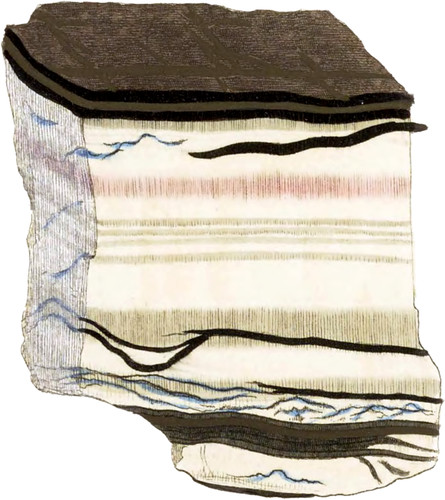 Enlarge
Enlarge
British Mineralogy
Satin Spar
- Class 2. Earth.
- Order 1. Homogeneous.
- Gen. 1. Lime.
- Spec. 2. Carbonate of Lime.
- Div. 1. Imitative.
My friend the Rev. Mr. J. Harriman first favoured me with a piece of this curious mineral, about the year 1797. It was then recently made known to the mineralogical world by Mr. Stag, who sent me a piece soon after. It is understood to have been discovered about ten years ago, about a mile from Alston in Cumberland, washed by the river Tyne, near the level of its bed, and no where else at present. The spot is about 30 yards long and 10 yards wide; the middle producing the broadest stratum, which was about 4 inches, soon narrowing and becoming full of veins. I was told it was a very pure carbonate of lime soona fter I received it, although it was kept a secret where it was found.
The colour is white, with a beautiful satiny lustre, showing the strata broad in the light and shade, and innumerable in the intermediate space, varying as they are directed to the light, which is best if perpendicular to them. It transmits light at the edges, or in thin pieces. The fracture in the direction of the striæ is fibrous, straight (perhaps with imperceptible undulations, whence the lustre), or crooked*, somewhat jagged, with a few flattish fragments. The cross fracture is nearly at right angles with the striæ, with a compact splintery dull surface, seldom in the direction of the strata, which are rarely quite at right angles with the striæ. It is much of the same hardness with the crystallized carbonate of lime, does not scratch with the nail, is brittle, and breaks most readily in the direction of the striæ.
Mr. H. Pepys junior seems first to have described this mineral in the Philosophical Magazine, vol. 12. p. 364; and according to his analysis it contains,
| Carbonic acid | 47.600 |
| Lime | 50.080 |
| †Iron | 012 |
| Loss of water of crystallization | 2.308 |
| 100.000 |
Spec. grav. 2.709 to 2.721.
It has been formed into snuff-boxes, and turned into studs, which look very pretty.
The blackish clay and metallic lustre of the pyrites give it a pretty relief; the top is an example of a septarium of some authors. The rosy blush is a very dilute iron stain.
- * I have a specimen with the striæ curved like the Italic ſ, and the fracture nearly at right angles with every curvature.
- † The iron need not be reckoned, as Mr. Pepys observed it was adventitious, pieces having been chosen quite free from iron.

